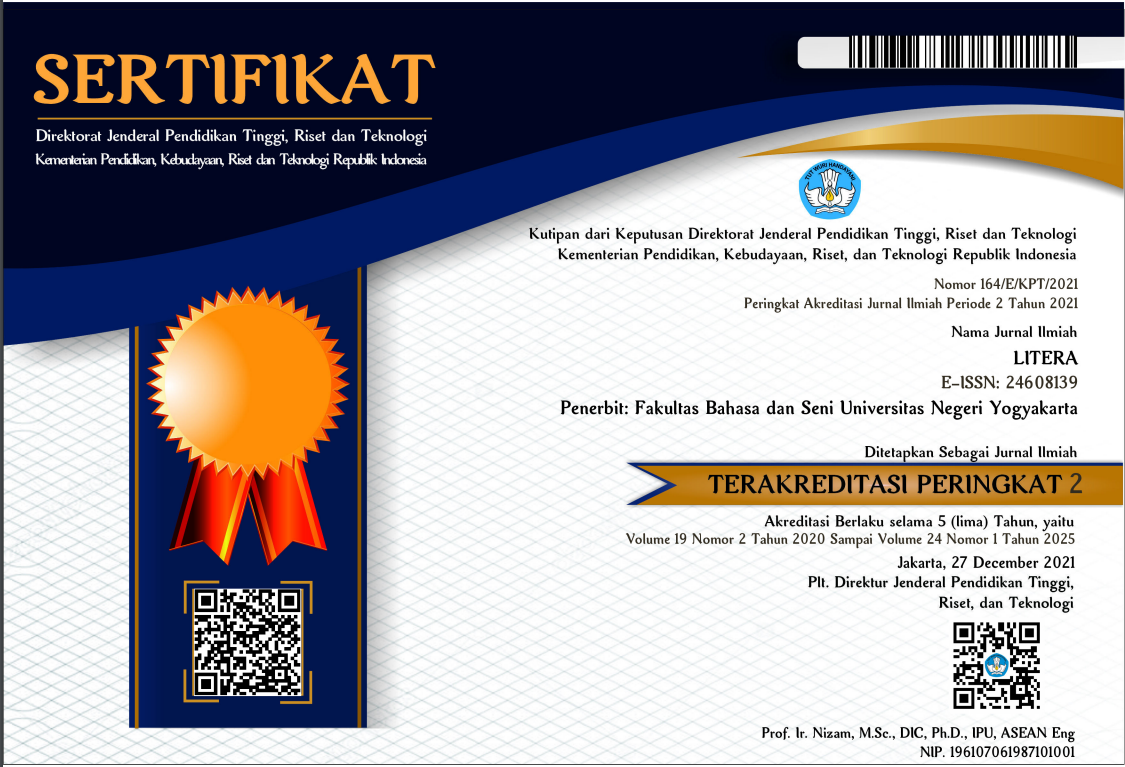STRATEGI KESANTUNAN TINDAK TUTUR DIREKTIF WERKUDARA DALAM WAYANG PURWA: ANALISIS POLA PROSODI
Downloads
Tokoh Werkudara (WR) memiliki kekhasan yang menjadikan tokoh tersebut unik dan berbeda dibanding tokoh lainya dalam pementasan wayang purwa. Secara kebahasaan tokoh WR memiliki gaya berbicara kasar dan tidak pernah berbicara halus, dan cenderung tidak santun terhadap mitra tuturnya. Tujuan penelitian ini adalah mendeskripsikan pola prosodi strategi kesantunan tindak tutur direktif yang dilakukan tokoh Werkudara dalam wayang purwa. Penelitian ini menggunakan data tindak tutur direktif yang dilakukan tokoh Werkudara dalam lakon Dewa Ruci dengan pemilihan kalimat target tindak tutur direktif requestives sub fungsi meminta dengan struktur S-P-Pel aku jaluk pamit dan tindak tutur direktif questions sub fungsi bertanya dengan strutur apa-S?. Sumber penelitian yang digunakan dalam penelitian ini adalah rekaman video pementasan wayang lakon Dewa Ruci oleh Ki Nartosabdo. Data tuturan tersebut diproses dengan menggunakan aplikasi Praat dengan berpedoman pada aturan IPO (Instituut voor Perceptie Onderzoek) guna menggambarkan dan mempersepsikan aspek prosodi dari tuturan Werkudara kepada masing-masing mitratuturnya. Penelitian ini menggunakan teori pragmatik sebagai pisau bedah guna menjelaskan hubungan pola prosodi dalam membangun kesatunan dengan mitra tutur. Hasil penelitian ini dapat dijelaskan tiga pola prosodi dalam tindak tutur direktif Werkudara, yaitu pertama, konteks mitra tutur (+D, +P "˜met') dalam tuturanya Werkudara menggunakan pola prosodi kontur nada turun atau deklinasi, julat nada tinggi (melodis), dan durasi panjang. Kedua konteks mitra tutur (-D, +P "˜met') menggunakan pola prosodi kontur nada turun atau deklinasi, julat nada kecil (monoton), dan durasi panjang. Ketiga, konteks mitra tutur (+D, +P "˜mat') menggunakan pola prosodi kontur nada naik atau inklinasi, julat nada kecil (monoton), dan durasi pendek.
Kata kunci: wayang purwa, werkudara, tindak tutur direktif, pola prosodi
POLITENESS STRATEGY OF DIRECTIVE SPEECH ACT OF WERKUDARA IN THE WAYANG PURWA: A PROSODIC ANALYSIS
Abstract
The Werkudara (WR) character has a peculiarity that makes this character unique and different from other characters in the shadow-puppet performances. Linguistically, the WR character has a harsh speaking style, never speaks softly, and tends to be disrespectful to his speech partners. The purpose of this study is to describe the prosody pattern of the directive speech acts of the politeness strategy performed by the Werkudara character in the puppet performance. This study uses the directive speech-act data performed by the character Werkudara in Dewa Ruci's play by selecting the target sentence directive speech-act requestives requesting sub-function with the structured target sentences S-P-Pel "˜aku jaluk pamit' and the directive speech acts question sub-function of asking with the structure what-S?. The research source used in this study was the video recording of the Dewa Ruci puppet performance by Ki Nartosabdo. Furthermore, the speech data is processed using the Praat application guided by the IPO rules (Instituut voor Perceptie Onderzoek) to describe and perceive the prosody aspects of Werkudara's speech to each of his partners. This study uses the pragmatic theory as a tool to explain prosody patterns in building politeness with speech partners. The results of the study indicate the three prosody patterns in the speech acts of the Werkudara as follows. First, the context of the speech partners (+ D, + P 'met') in Werkudara's speech uses the prosody pattern of downward pitch or declination contours, high pitch range (melodic), and long duration. Second, the two contexts of speech partners (-D, + P 'met') use a downward or declination prosody pattern, a small pitch range (monotone), and a long duration. Third, the context of speech partners (+ D, + P 'mat') uses a prosody pattern of rising or inclination contours, small pitch ranges (monotone), and short duration.
Keys word: shadow puppet, Werkudara, directive speech acts, prosody patterns.
Adikara, S. (1984). Unio Mystica Bima. Bandung: ITB Press.
Brown, & Gilman. (1960). The Pronouns of Power and Solidarity. MIT Press.
Brown, P., & Levinson, S. C. (1983). Politeness Some Universals in Language Usage. Cambridge: Cambridge University Press.
Chaer, A. (2009). Fonologi Bahasa Indonesia. Jakarta: Rineka Cipta.
Culpaper, J. (2003). (Im)politeness: Prosody and Gesture. Journal of Pragmatics, 35.
Culpeper, J. (2011a). "˜It's not what you said, it's how you said it!': Prosody and impoliteness. In Discursive Approaches to Politeness. Berlin: De Gruyter Mouton.
Culpeper, J. (2011b). It's not what you said, it"Ÿs how you said it!"Ÿ: Prosody and impoliteness. Linguistic Politeness Research Group (Eds.) Discursive Approaches to Politeness.
Heriyawati, D. F., Siba, S. Y., & Sulistyo, T. (2019). Lecturers' Politeness Strategies in Efl Classroom with Multicultural Background. Litera, 18.
Huang, Y. (2007). Pragmatics. Oxford: Oxford University Press.
Isnaniah, S. (2010). DEWA RUCI : SEBUAH ALTERNATIF SISTEM PENDIDIKAN. LiNGUA, 5.
Lisbijanto, H. (2013). Wayang. Yogyakarta: Graha Ilmu.
Manaf, N. A. (2011). Kesopanan Tindak Tutur Menyuruh dalam Bahasa Indonesia. Litera, 10.
Musbikin, I. (2010). Serat Dewa Ruci. Yogyakarta: Diva Press.
Nadeu, M. (2014). Pitch range, gestural information, and perceived politeness in Catalan. Journal of Pragmatics, 43.
Nanda. (2010). Wayang. Yogyakarta: Bintang cemerlang.
Navarro, A. H., & Nebot, A. C. (2014). On the Importance of the Prosodic Component in the Expression of Linguistic im/Politeness. Journal of Politeness Research, 10. https://doi.org/DOI 10.1515/pr-2014-0002
Poedjoesoedarmo. (1986). Ragam Panggung dalam Bahasa Jawa. Jakarta: Pusat Pembinaan dan Pengembangan Bahasa.
Rahardi, K. (1999a). Imperatif dalam Bahasa Indonesia: Penanda-Penanda Kesantunan Linguistik. Humaniora.
Rahardi, K. (1999b). Imperatif Dalam Bahasa Indonesia Penanda-Penanda Kesantunan Linguistiknya. Humaniora.
Rahyono, F. X. (2009). The Politeness Prosody of the Javanese Directive Speech. Wacana, 11, 258"”278.
Sena Wangi. (1999). Ensiklopedia Wayang Indonesia. Jakarta: PT Sakanindo Printama.
Soetarno. (1994). Ensiklopedia Wayang. Semarang: Dahara Prize.
Sudaryanto. (1993). Metode Aneka Teknik Analisis Bahasa Pengantar Penelitian Wahana Kebudayaan Secara Linguistis. Yogyakarta: Duta Wacana University Press.
Sugiyono. (2007). Prosodic Markers of Statement-Question Contrast in Kutai Malay. Leiden: LOT.
Sujamto. (1992). Wayang dan Budaya Jawa. Semarang: Dahara Prize.
Sumari. (2016). Almanak Wayang Indonesia. Jakarta: Prenadamedia.
Sutardjo, I. (2010). Keindahan Bahasa Pedalangan. Solo: FSSR Publishing.
Tondowidjojo, J. (2013). Enneagram Dalam Wayang Purwa. Jakarta: Gramedia Pustaka Utama.
Widyawati, W. (2009). Ensiklopedia Wayang. Yogyakarta: Pura Pustaka.





















